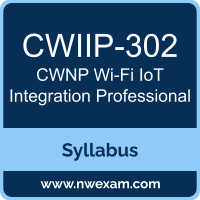 A great way to start the CWNP Certified Wireless IoT Integration Professional (CWIIP) preparation is to begin by properly appreciating the role that syllabus and study guide play in the CWNP CWIIP-302 certification exam. This study guide is an instrument to get you on the same page with CWNP and understand the nature of the CWNP Wi-Fi IoT Integration Professional exam.
A great way to start the CWNP Certified Wireless IoT Integration Professional (CWIIP) preparation is to begin by properly appreciating the role that syllabus and study guide play in the CWNP CWIIP-302 certification exam. This study guide is an instrument to get you on the same page with CWNP and understand the nature of the CWNP Wi-Fi IoT Integration Professional exam.
Our team of experts has composed this CWNP CWIIP-302 exam preparation guide to provide the overview about CWNP Wireless IoT Integration Professional exam, study material, sample questions, practice exam and ways to interpret the exam objectives to help you assess your readiness for the CWNP CWIIP exam by identifying prerequisite areas of knowledge. We recommend you to refer the simulation questions and practice test listed in this guide to determine what type of questions will be asked and the level of difficulty that could be tested in the CWNP Wi-Fi IoT Integration Professional certification exam.
CWNP CWIIP-302 Exam Overview:
|
Exam Name
|
Wireless IoT Integration Professional |
| Exam Number | CWIIP-302 CWIIP |
| Exam Price | $350 USD |
| Duration | 90 minutes |
| Number of Questions | 60 |
| Passing Score | 70% |
| Exam Registration | Prometric |
| Sample Questions | CWNP CWIIP-302 Sample Questions |
| Practice Exam | CWNP Certified Wireless IoT Integration Professional Practice Test |
CWNP CWIIP-302 Exam Topics:
| Section | Weight | Objectives |
|---|---|---|
| Explain and Use Integration Technologies | 20% |
- Demonstrate proficiency in selecting the best use of integration technologies for wireless IoT solutions.
- Compare and contrast streaming and polling methods
|
| Perform Requirements Analysis (IEEE 29148:2018) | 20% |
- Identify business requirements
- Identify System/Software requirements
- Identify Extract, Transform, and Load (ETL) requirements
|
| Develop IoT Integration Solutions | 40% |
- Demonstrate proficiency with Python
- Process data contained in commonly used IoT data structures
- Understand and interact with data storage systems
- Understand and interact with real time data
- Understand and implement security methods
- Troubleshoot problem scenarios
|
| Implement IoT Integration Solutions | 10% |
- Implement a method to display, monitor, and provide alerts
- Implement automation to provision, configure, and interact with IoT devices
|
| Maintain and Support IoT Integration Solutions | 10% |
- Utilize Git for version control
- Continued software maintenance and support (package managers) - Documentation
- Perform validation
- System lifecycle management
- Utilize best practices and methodologies
- Understand the role and function of industry organizations:
|
CWNP CWIIP Exam Description:
The Certified Wireless IoT Integration Professional (CWIIP) develops and implements solutions that integrate multiple wireless-sourced management, monitoring, and control data through programming. This professional can identify and use the appropriate tools to extract, transform, and load data to and from wireless Internet of Things (IoT) systems. The CWIIP plays a crucial role in planning and delivering scalable solutions to automate the transport of and response to data throughout a heterogeneous network.
